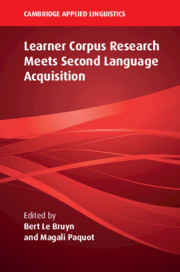Book contents
- Learner Corpus Research Meets Second Language Acquisition
- The Cambridge Applied Linguistics Series
- Learner Corpus Research Meets Second Language Acquisition
- Copyright page
- Contents
- Figures
- Tables
- Contributors
- Series Editors’ Preface
- Learner Corpus Research and Second Language Acquisition: an attempt at bridging the gap
- Article Use in Russian and Spanish Learner Writing at CEFR B1 and B2 Levels: Effects of Proficiency, Native Language, and Specificity
- L1 Influence vs. Universal Mechanisms: An SLA-Driven Corpus Study on Temporal Expression
- The Interplay between Universal Processes and Cross-Linguistic Influence in the Light of Learner Corpus Data: Examining Shared Features of Non-native Englishes
- Exploring Multi-Word Combinations as Measures of Linguistic Accuracy in Second Language Writing
- Using Syntactic Co-occurrences to Trace Phraseological Complexity Development in Learner Writing: Verb + Object Structures in LONGDALE
- Understanding the Long-Term Evolution of L2 Lexical Diversity: The Contribution of a Longitudinal Learner Corpus
- L2 Developmental Measures from a Dynamic Perspective
- Exploring Individual Variation in Learner Corpus Research: Methodological Suggestions
- Building an Oral and Written Learner Corpus of a School Programme: Methodological Issues
- Commentary: Have Learner Corpus Research and Second Language Acquisition Finally Met?
- Commentary: An SLA Perspective on Learner Corpus Research
- Index
- References
Understanding the Long-Term Evolution of L2 Lexical Diversity: The Contribution of a Longitudinal Learner Corpus
Published online by Cambridge University Press: 29 December 2020
- Learner Corpus Research Meets Second Language Acquisition
- The Cambridge Applied Linguistics Series
- Learner Corpus Research Meets Second Language Acquisition
- Copyright page
- Contents
- Figures
- Tables
- Contributors
- Series Editors’ Preface
- Learner Corpus Research and Second Language Acquisition: an attempt at bridging the gap
- Article Use in Russian and Spanish Learner Writing at CEFR B1 and B2 Levels: Effects of Proficiency, Native Language, and Specificity
- L1 Influence vs. Universal Mechanisms: An SLA-Driven Corpus Study on Temporal Expression
- The Interplay between Universal Processes and Cross-Linguistic Influence in the Light of Learner Corpus Data: Examining Shared Features of Non-native Englishes
- Exploring Multi-Word Combinations as Measures of Linguistic Accuracy in Second Language Writing
- Using Syntactic Co-occurrences to Trace Phraseological Complexity Development in Learner Writing: Verb + Object Structures in LONGDALE
- Understanding the Long-Term Evolution of L2 Lexical Diversity: The Contribution of a Longitudinal Learner Corpus
- L2 Developmental Measures from a Dynamic Perspective
- Exploring Individual Variation in Learner Corpus Research: Methodological Suggestions
- Building an Oral and Written Learner Corpus of a School Programme: Methodological Issues
- Commentary: Have Learner Corpus Research and Second Language Acquisition Finally Met?
- Commentary: An SLA Perspective on Learner Corpus Research
- Index
- References
Summary
This study investigated the long-term evolution of lexical diversity of adult L2 learners of French and Spanish (n = 33) over a five-year period. A longitudinal learner corpus was collected that includes oral (semi-structured interview, picture-based narrative) and written (argumentative essay) data. Three data collection waves are investigated in the current study: (a) before learners studied abroad as part of their university degree program, (b) at the end of their nine-month stay abroad, and (c) three years post-instruction. In addition to examining the potential outcomes of attrition, maintenance, or development, this study explores the extent to which variables such as peak attainment and language exposure/use predict changes in lexical diversity three years post-instruction. Results of ANOVA analyses indicate continued improvement in lexical diversity post-instruction for oral but not written tasks. Regression analyses indicate that both peak attainment in lexical diversity and language exposure/use contribute significantly to predicting gains in lexical diversity post-instruction on both oral tasks, with peak attainment explaining more of the variance than language exposure. The findings help us better understand the variables that influence the long-term evolution of foreign language proficiency after the conclusion of formal instruction.
Keywords
- Type
- Chapter
- Information
- Learner Corpus Research Meets Second Language Acquisition , pp. 148 - 171Publisher: Cambridge University PressPrint publication year: 2021

